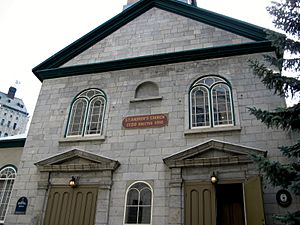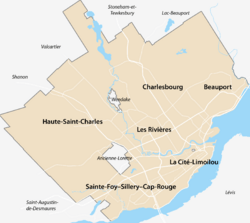St. Andrew's Church (Quebec City) facts for kids
Quick facts for kids St. Andrew's Church |
|
|---|---|

St. Andrew's Presbyterian Church on rue Sainte-Anne in the Upper Town of Old Quebec.
|
|
| 46°48′46.67″N 71°12′34.78″W / 46.8129639°N 71.2096611°W | |
| Location | Quebec City, Quebec |
| Country | Canada |
| Denomination | Presbyterian |
| History | |
| Status | Church |
| Founded | 1759 |
| Founder(s) | Rev. Robert MacPherson |
| Dedication | Andrew the Apostle |
| Dedicated | 30 November 1810 |
| Architecture | |
| Functional status | Active |
| Architect(s) | John Bryson |
| Groundbreaking | 1809 |
| Completed | 1810 |
| Construction cost | £1,500 |
| Specifications | |
| Capacity | 600 |
| Administration | |
| Presbytery | Presbytery of Quebec |
| Synod | Synod of Quebec and Eastern Ontario |
St. Andrew's Presbyterian Church (French: Église presbytérienne Saint Andrew) is a Presbyterian church in Quebec City, Quebec, Canada. It is part of the Presbyterian Church in Canada group of churches.
Contents
A Look at the Church's History
How the Church Began
The story of St. Andrew's Church started when the British took over Quebec in 1759. This happened after a big battle called the Plains of Abraham. A minister named Robert MacPherson, who was a chaplain for the Church of Scotland, led a group of soldiers. These soldiers were from the famous 78th Fraser Highlanders who fought with James Wolfe's army.
This group of people grew into a church community under MacPherson's leadership. He continued to lead them until he passed away in 1765. Another former chaplain, George Henry, took over after him.
Becoming a Civilian Church
After the Treaty of Paris was signed in 1763, more people from Scotland and New England came to Quebec. These were often merchants and traders. The church community then became a civilian group, meaning it was for everyone, not just soldiers. It was known as the Scotch Congregation - in connection with the Church of Scotland.
Building the Church
In 1802, during the time of Minister Alexander Spark, many people asked for a place to build a new church. King George III agreed and gave them the land where the church stands today. However, construction didn't start until 1807.
The church building was finally finished and officially opened on November 30, 1810. This date is also St. Andrew's Day, which is why the church was named after Andrew the Apostle. The building looks almost the same today as it did then, except for a small addition called the Vestry that was built in 1900.
Other Important Buildings
On the same piece of land as the church, there are two other important buildings. One is the Kirk Hall, which was first built in 1829. It started as a Protestant School and was a very successful school for many years.
The other building is a beautiful house called the Manse. It was built in 1837 and was where the church ministers lived until 2017. A famous musician named William Reed was the church's organist from 1900 to 1913.
Ministers Who Served the Church
Many ministers have led the St. Andrew's Presbyterian Church over the years. Here is a list of some of them:
- Robert MacPherson, 1759-1765 (Died in Office)
- George Henry, 1765-1784
- Alexander Spark, 1784-1819
- James Harkness, 1820-1835 (Died in Office)
- John Cook, 1836-1883. He was the leader of the first big meeting of the Presbyterian Church in Canada in June 1875.
- Andrew Tannahill Love, 1884-1925
- Alexander M. Gordon, 1926-1941
- Harold W. Reid, 1941-1945
- Donald Mackay, 1945-1950
- Wilfred Butcher, 1951-1964
- Edward Bragg, 1964-1977
- P. Lyle Sams, 1979-1990
- Donald J. M. Corbett, 1991-present. He was also a former leader of Knox College.
- Mrs. Tamiko Nakamura Corbett, 1992-1993. She was a leader of the Presbyterian Church in Canada's General Assembly in 1996.
- Ronald H. Balston, 1993-1996
- Scott Emery, 1996-2000
- Bradley Nelson (Interim Minister), 2001-2003
- Stephen A. Hayes, 2004-2009
- Katherine Burgess, 2009–present
Images for kids






